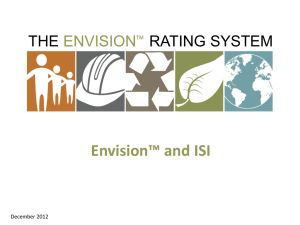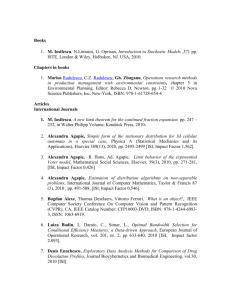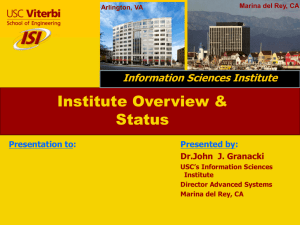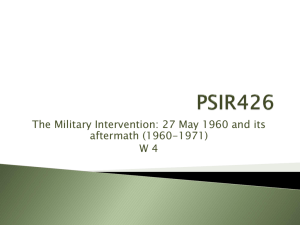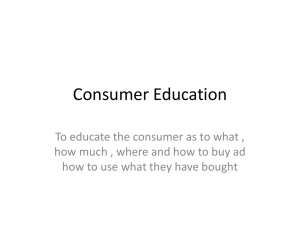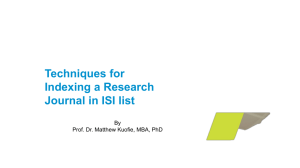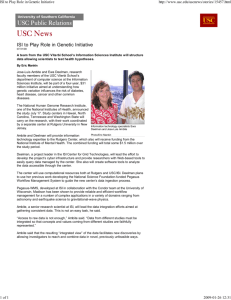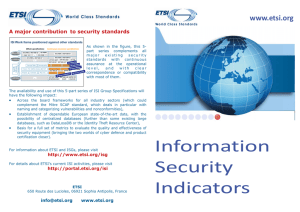Independent Science Investigations
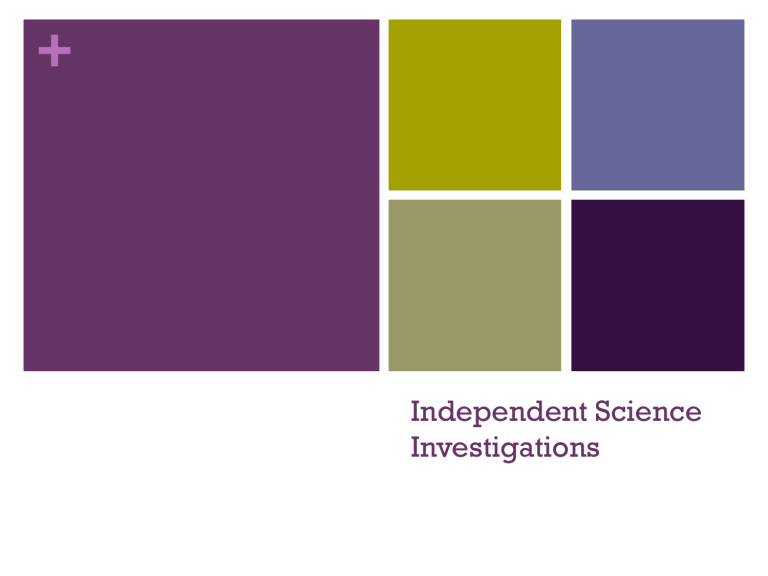
+
Independent Science
Investigations
+
What is an Independent Science
Investigation (ISI)?
The ISI project will give you a chance to design your own learning experience, one that allows you to innovate, just as scientists do in the real world.
You will be able to explore personal interests while selecting an area for your project, as well as apply the scientific method to answer a question.
Think science fair without the competition
+
Why do an Independent Science
Investigation (ISI)
You will also develop your 21st century skills above and beyond science.
Reading Comprehension and Writing: Doing background research and writing a research paper
Math: Creating graphs and performing data analysis
Time Management: Planning and conducting a long term, multi-step project
Problem Solving: Designing an experiment to answer a question and making any mid-course changes
Communication: Presenting and explaining the project
Ethics Understanding: Learning about plagiarism and the importance of credit and citations
Real World Technology Application: The use of word processing and spreadsheet programs to create a display
+
Parts of the ISI
Project Journal – This is where you will record EVERYTHING about your project from brainstorming ideas, to project development, data collection and analysis, etc.
+
Deciding On a Topic
The important thing is to:
find something that interests you
what are your hobbies,
what do you like to do in your spare time,
What sports you like
As you select your project topic, DO NOT copy something you find in a book or on the internet! You can use these ideas as starting point, but find a way to make it your own unique idea.
+
Project Topic Selection Example
How I selected my last project:
Like microbiology and working with bacteria
Used bacteria in past projects
Heard about a bioluminescent bacteria that could light up called
Vibrio fischeri
+
Project Topic Selection Example
Did preliminary research and found out that there was a symbiotic relationship between the Bobtail squid and Vibrio fischeri bacteria. Thought it would be fun to work with these squid but further research showed it was very difficult to keep them in captivity and that they did not live long.
Additional research showed that some research had been done with Vibrio fischeri as an indicator for water quality in a lab. Decided to test to see if it could be used as an efficient way to test water quality in the Fountain Creek Water Basin.
+
Parts of the ISI
Testable Question – What is it I want to find out about a topic
Start with hobbies, sports, whatever you are interested in
This is NOT a question that you can find the answer in a book or on the internet; it must be a question that will support you doing a science experiment, collecting data, and then analyzing the data to answer the question.
+
Developing a Testable Question
Remember, this is NOT a question that you can find the answer in a book or on the internet; it must be a question that will support you doing a science experiment, collecting data, and then analyzing the data to answer the question.
Examples:
How big is Vibrio fischeri? –
Not good Found through book/internet research not an experiment
How many Vibrio fischeri are in the world? – Not good Impossible to calculate, not an experiment
My Testable Question
+
Parts of the ISI
Background Research and Paper – This is an important step so that you know how to design and understand your experiment
Need at least 3 different sources to verify accuracy
Write a minimum of one page summary of your research that includes any formulas, or key data to conduct your experiment
+
Parts of the ISI
Hypothesis – An educated guess based on your background research
You should not know the answer
Most of the time a hypothesis is written like this: "If _____[I do this]
_____, then _____[this]_____ will happen.”
+
Developing your Hypothesis
Remember it is an educated guess based on your background research
You should not know the answer
Most of the time a hypothesis is written like this: "If _____[I do this]
_____, then _____[this]_____ will happen.”
Examples:
If I put swimming pool chlorine into the vibrio fischeri broth, then they will die. – Not good You know this answer
My Hypothesis based on background research
+
Parts of the ISI
Materials List –What supplies and equipment will you need to complete your project
Look at your procedure and make a complete list of everything you need to do each step
Make sure that you have everything on hand before you need it
+
Parts of the ISI
Procedure – This is a step-bystep recipe for your science experiment
A good procedure is so detailed and complete that it lets someone else duplicate your experiment exactly!
You need to repeat it a minimum of three times (more is better) to verify results
It is created as a numbered list of steps performed in a specific order
All measurements must be in metric units
+
Parts of the ISI
Experiment & Data Collection – Follow your procedure exactly. If you need to make changes in the procedure (which often happens), write down the changes exactly as you made them.
Before starting your experiment, prepare a data table in your journal so you can quickly write down your measurements as you observe them
Be consistent, careful, and accurate when you take your measurements (must be in metric units)
+
Project Experimentation &
Data Collection
+
Parts of the ISI
Data Analysis – Review your data looking at the results of your experiment with a critical eye
Create both data tables and graphs to help you analyze the data, these will also make it easy for people to read on your display
This is usually your longest written section on your display
+
Parts of the ISI
Conclusion – Your conclusions summarize how your results support or contradict your original hypothesis (Short 1 paragraph)
Application – How does your research apply to real life
+
Parts of the ISI
Display Board –You need to prepare a display board to communicate your work to others.
In most cases you will use a standard, three-panel display board that unfolds to be 36" tall by 48" wide.
This must be professional, all information should be word processed, graphs and tables should be created with a spreadsheet program.
+
Parts of the ISI
Report – Your report will contain everything in steps 2 through 10 above plus an abstract and bibliography
An abstract is an abbreviated version of your ISI project’s final report
Limited to a maximum of 250 words
Bibliography should be in MLA format (use Easybib on our web site to create)
+
Project Limitations
Projects that include any one of the following will require approval before starting project. (We will use the ISEF
Rules and Guidelines)
Human subjects
Vertebrate animals
Live, nonhuman vertebrate mammalian embryos or fetuses
Bird and reptile eggs within 3 days of hatching
All other nonhuman vertebrates
(including fish) at hatching or birth
Zebrafish embryos 7 days (168 hours) post fertilization
+
Project Limitations
Projects that include any one of the following will require approval before starting project. (We will use the ISEF Rules and Guidelines)
Potentially hazardous biological agents
Microorganisms (including bacteria, viruses, fungi, etc.)
Recombinant DNA
Human or animal fresh/frozen tissues, blood or body fluids
Hazardous chemicals, activities or devices include
Chemicals
Equipment
DEA-Controlled Substances
Prescription Drugs
Alcohol and Tobacco
Firearms and Explosives
Radiation
+
Project Examples
Take a few minutes to look at the example projects as you leave.
+
Support
Freedom Elementary has created a web page with resources for both students and parents
http://freedom.d11.org/Pages/Independent-Science-
Investigation.aspx
Student ISI Outline
Student ISI Timeline
Parent letter with timeline
+
The Future: Science Competitions
Pikes Peak Regional Science Fair
Who: Open to all 6 th – 12 th grade students in the Pikes Peak region
When: March
Prizes: Cash and gifts from sponsors
Colorado State Science and
Engineering Fair
Who: 6 th – 12 th grade students
Top winners from regional competitions invited to compete
When: April
Prizes: Cash and gifts from sponsors
+
The Future: Science Competitions
International Science and
Engineering Fairs
Who: 9 th – 12 th grade students
Top winners from regional, state, and country competitions invited to compete
When: May - August
Prizes: Cash, scholarships, and gifts from sponsors
Top prizes $75,000, Intel gave away more than $3 million dollars at this year’s competition!
Paid travel to compete
+
Benefits
Learn more about topics you are interested in
Meet new friends!
Win Money
Prizes
Scholarships
